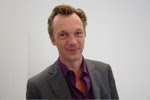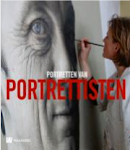

No, my husband said, it only looks like, it is not Dijkstra's work. He was right. It was Charles Freger work, showing rows and rows of chest portraits of naked men. Same background (a white backdrop!?), the same unsure looks, the variety in the repetition.

Some days later in Vienna I went to Krinzinger Gallery, I know this gallery from the Art Fair in Mexico last year so after receiving regular digital invitations I had I a chance to see their space. It resulted that it is a great space, (with one of the kindest receptionist I ever met at a gallery!).


The work of Ulrike Lienbacher I have seen it on Internet: the red, hairy drawings that could make you think of Babette Wagenvoort's in The Hague. Yes, attractive big hairy drawings but as the receptionist told me, she just started photographing. What do I see? Again Rineke Dijkstra's style: rows of unsure teenagers who just stopped sporting, with that "Vondel Park" like backgrounds of Dijkstra. Same hanging, same looks, same compositions, the insecurity, the youth, all the same (of course not exactly the same).
So, what is it happening? Is it that everybody is copying Rineke, which I doubt, may be some of them are copies, like the drinks advertisement from years ago, but not all. Is it that Rineke copied others? Is it that this is the photographic synthesis of this days' photography?
Any way, here are the examples. And by the way after Krinzinger I went to Gallery Mario Mauroner and what do I see? Again the red hairy drawings by the Spanish artist


 Javier Perez, luckily only a few among a wide variety of works and materials, but still very much like Urike's.
Javier Perez, luckily only a few among a wide variety of works and materials, but still very much like Urike's.As artists we are not alone, it seems as there is always someone doing the same things you do. Maybe that is the truth.
Photographs: Rineke Dijkstra (2x), Charles Freger, Ulrike Lienbacher (2x).
Red hairy drawings: Babette Wagenvoort, Ulrike Lienbacher, Javier Perez.




















2 comments:
hello,
Briefly, I think you are going a bit too fast in the way you are judging my work or the work of some photographers working in that type of frontal portraits.
There are a lot of photographers doing portrait in that way, frontal, uniform coming from different schools and tendances, like Albrecht Tubke, Bernard Fuchs in Germany... Morten Nilsson in Denmark and many more!
Maybe our work is 'in the air' but still, you can find a certain diversity in the way we all work: in the choice of our topic, our light, the choice of a background, the type of our prints, etc.
I work in a serial project, something which is more an accumulation of portraits. I purchase a research about the individual in the context of the group, choosing my environement, my background (I don't use any backdrop...). My research is about the feeling of beeing part of a group (and myself being the outsider of the group I photograph).
I invite you to have a look on my website www.charlesfreger.com to see more images, to get them in their original context.
All the best
Charles Freger
Dear Charles,
Thank you very much for your lines.
I very much agree with what you say, and before I wrote my blog I had seen more of your photographs and they had a lot of variety within the portraiture.
But the photos I saw in Budapest passed in this description.
If you read some other inserts of mine I am talking about coincidence. How many times you had been confronted with someones work to see a big part of your own's or own ideas in it?
My questions are, how does it happens? Where is fashion? Where is culture? Where is the copy and where is the inspiration? They are open questions that I confront my self also about my own work.
I like finding this similar situations in art and in society.
With my own (paint) portraits I also get info on other artist's works that my firends feel are very similar, of course (mostly) not for me, because I am inside.
And going to the bottom of the topic what says more about us humans than our faces?
And even though, some people find it so old fashion when I say: -portraits-.
Best regards,
Marisa Polin
Post a Comment